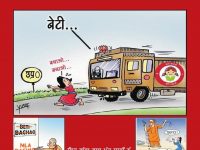While people of several cities in the country including capital Delhi choked on the air oversaturated with particulate matter, the ruling elite of the country could ultimately pin down the culprit behind this sordid conspiracy, the poor peasant of Punjab and also of Haryana. The exercise undertaken by the govts. at the Centre and the state govt. of the territory of Delhi and the ultimate in the judiciary in the country, the Supreme Court, came down heavily on this ‘terrorist’ out to destroy the peaceful life of the urban conglomerate. State Govts. of Punjab, Haryana and UP have been ordered to stop nefarious activity of stubble burning by this trouble maker. Though air pollution in Delhi has invited the concern of the ruling elite, the condition in the whole of North India is abysmal and several cities, poor cousins of the capital, suffer even worse situation in terms of air pollution.
Undoubtedly the air pollution in the country has reached dangerous levels and capital Delhi has emerged as the pollution capital of the world, the most polluted city among the 1600 major cities investigated by World Health Organization (WHO). Not only Delhi, other cities of India are not far behind. 13 out of the 20 most polluted cities are in our country. Air pollution kills 1.5 million people every year in the country. Nearly half of the newborns in the country (2.2 million) suffer from the lung damage owing to high levels of air pollution. These are some of the facts in circulation. While the extent of the air pollution and its ill effects are undoubted, causes behind this are most debated. While the Govt. of Territory of Delhi has routinely announced “Odd Even” Scheme for use of private cars only after the prediction of turn in weather to enable AAP Govt. to claim success, it is more a show to meet the criticism of its inactivity than any proven effect at the stage when air pollution has crossed measurable limits. This is like putting of police check posts after any incident of blast in all corners of Delhi. Its target is gullible people and not air pollution. Deputy Chief Minister Manish Sishodia rode on a cycle to his office. He was apparently not communicated the advisory issued by Health Minister of Delhi to not undertake physical activity in the open. Central Govt. is smug with the success of its “Swatch Bharat Abhiyan” with its photo-ops though air pollution has not responded and which is not their fault. After all there was no pollution in ancient India and repository of our rulers does not go beyond that. Environment Minister Javadekar has prescribed to “start your day with the music” though not suggesting type of music which can act as deterrent to the effects of air pollution. Health Minister Harshvardhan prescribed eating of carrots to minimize effects of air pollution signaling that the Govt. has no intention of taking steps to reduce it. While the ruling elite including Govts. at the Centre and states and also judiciary talked (and only talked) of curbing Diwali celebrations with firecrackers which lead to both smoke, noxious gases and particles, but it hardly had any effect because it was mere talk. It still continues to be an important in the sharp spike in pollution levels in Delhi.
According to Centre for Science and Environment (CSE) 65% of the air pollution in Delhi is due to local sources i.e. generated due to activity in Delhi. According to the Centre, whose Chairperson is on the Supreme Court appointed Committee on Environment, stubble burning in Punjab and Haryana contributes about 5 to 7% of the pollution load in Delhi. While stubble burning by peasants is a favourite whipping boy of the Central and State govts. they do not bother to explain why there is excessive particulate matter in the air in several areas of Delhi and that too not uniformly. Obviously this cannot be due to pollutants carried by air from afar. According to the CSE there are 14 such areas in Delhi and burning of municipal solid waste and industrial waste is a big contributor to the air pollution.
Ministry of Earth Sciences of the Central Govt. had brought out a research paper in October 2018 on the air pollution in Delhi. According to that paper, 41% of the particulate matter in the air of Delhi is due to vehicular emissions, 21.5% is contributed by the dust and 18% by the industries. The Association of Automobile makers has seen to it that the report is consigned to the dustbin and no Govt. will take it out given the alarming slowdown in the automobile industry. There are seven millions of motorcycles and scooters in Delhi. Badarpur Power Plant (Closed since 2018 end) had been another contributor of the particulate matter. According to a report, while it contributed to only 8% of the power supply in Delhi, it accounted for nearly 80 to 90% of the particulate matter pollution from the electric power sector in Delhi. There are many hotspots of air pollution in Delhi including Bhalswa and Ghazipur landfills which remain unattended by the two Govts. Both the govts. believe in perception management as the means to power as shows in the inaction in tackling fire simmering for months in landfills. AAP Govt. has boasted of distribution of masks among students but a large number of them are not given these as yet. What will the purpose of giving after the peak is over except the profit of mask makers? The claims of the Delhi Govt. for having reduced pollution levels by 25% over past few years has been challenged by the environmental groups. It has been pointed out that the assessment teams of the Central Pollution Control Board, which are set up in various parts of Delhi have not recorded this improvement. Detoxifying arrangements for sulphur gases have not been installed at electric generation plants in Delhi and a second deadline for the same has been given to the Delhi Govt. in the course of the current proceedings in the Supreme Court.
It is only in months of October-December that this problem is talked of while air pollution levels remain high throughout the year. Particulate Matter (PM) levels remain between 101 to 200 from January to September. This is much higher than the prescribed limit by the WHO i.e. below 25. However, between October to December the levels go through the roof breaking the record and record keeping machines. This is the time when two additional factors come into play. One is the cold weather which precipitates the PM and keeps it in the air. Also relatively stagnant air which is common during this season compounds this problem. In this season, peasants in Punjab and Haryana clear their land for sowing for Rabi crops. With the new harvesters the stubble left standing in the fields, has to be cleared for sowing. Poor and even middle peasants cannot afford machines for the purpose and hence burn it in the fields. This smoke is carried by air to distant places thus its dispersal is dependent on the air movement. Westernly winds carry this smoke to Delhi and other cities aggravating the air pollution there with clearance being slow for the above listed factors. Contribution of this factor, though small overall, becomes significant in this season. However, one-sided emphasis on this factor is misplaced and shows that the ruling elite is unwilling to address other factors which lead to increase in PM in the air, namely dust (generated by construction activity) and vehicular emissions. They are callous even in addressing disposal of industrial and municipal waste because much more powerful forces are involved. This partly explains the emphasis on poor (and middle) peasants.
Ruling classes and the corporate media also avoid the real cause behind this increase in stubble burning. To an extent stubble burning has been prevalent from old times as a practice by peasants throughout the country but its recent spurt in Punjab and Haryana has been spurred by imperialist sponsored model of agricultural development called Green Revolution. These areas saw multi-crops in this season (Maize, Jwar, Bajra, Pulses and Peanuts etc. were sown in this season) which have been replaced by paddy cultivation which has not been the traditional crop of this region. This large scale rice plantation has depleted the water table in the region and the Govt. forced peasants since past few years to delay paddy plantation from early May to late June which makes this crop ripen at the end of October and peasants including small peasants have a very small window of time to prepare the land for sowing of Rabi crop. Hence the stubble clearance is now done at a time when weather turns in this region. But the Govts. are silent on this as these are wedded to the imperialist interests behind this change.
One hears talk of ban on construction activity but a cursory survey would show that it is more on paper while construction activity goes on. Similarly the question of industrial waste management is not addressed by the Govt. It needs Govt. intervention in case of small industries which cannot afford their own plants for the purpose. Nearly three decades back a number of small industries were thrown out of Delhi on this pretext bur really to exploit the higher commercial value. At that time TUs and democratic organizations had demanded that Govt. take the responsibility of waste management of small industries but the Govts. serving the interests of big capitalists including foreign capital turned a deaf ear, throwing these units and thereby their waste to remote areas. Even now the Govts. target these employment generating small units but refuse to take responsibility of the waste management. And who will talk about municipal waste management, which squarely falls within the purview of the Govt? These factors operate round the year but ruling elite hardly bothers about them.
The ruling elite can hardly address this problem except take ameliorative steps when crisis situation supervenes. They are obsessed with spurring growth by any means and any planned development is a taboo to them, smelling as it does of ‘socialism’ to them. They wish to unleash the “animal spirits” of the capitalism to usher in their development and these animal spirits are soaked with the pollutants as they crave for increasing profits by all means. Industrial safety is not their concern and they leave behind the waste for others. Govt. on the other hand has no appetite to spend for the people, obsessed as they are with showering benefits on the corporate. So any planning for the well being of the people including taking care of healthy air is not on their agenda. A large populace of India does not yet have clean water and now even larger number is deprived of clean air as well. But these systemic causes are not the concern of the Govt. or Judiciary.
Hearing this matter, Supreme Court Bench presided over by Justice Arun Mishra called the actions of the Govts. as “gimmicks” which is not much off the mark. The Bench went on to say that these Govts. are interested only in gimmicks and elections. It is doubtful whether their response would be better if the ruling classes do away with the elections all together. In fact, the Supreme Court left much to be desired in its order. While it did question the Govt. of Delhi on its failure to add 3000 buses to the DTC fleet which it had promised last year (Delhi Govt. added only 120), the Court could have issued simple directions like reducing fares of the metro which have gone beyond the reach of common people. It could have directed the Central and State Govts. to meet the expenses of clearing the stubble in the first hearing itself. They did not direct these obvious measures.
After breast beating by the Govts. and other state institutions like judiciary, it will be the weather goddess which will as it always does come to the rescue and bring the PM levels to the poor or very poor from the severe. The air movement will take away some part, rain will also lend a helping hand. In the meanwhile, millions will suffer from lung ailments, lakhs will die of them and children will be the particular victims of the lung damage at a vulnerable age. Rulers have no desire to address the causes. They must be seen to be concerned and they are going through the motions. Once the severe phase passed it will be business as usual.
(On 6th of November, the Supreme Court passed an order directing the state govts. to pay Rs. 100 per quintal to peasants to clear the stubble. Govts. are also directed to provide machines to peasants. While this order is better than the earlier it does not take care of the totality of the conditions of the peasants who are forced to take recourse to stubble burning. It is doubtful whether this payment will be able to address the question. We have to see this in the backdrop of increasing indebtedness of peasants due to squeezing of their incomes as input costs increase but the prices of agricultural produce do not keep pace. In fact agrarian crisis has deepened greatly and small peasants are its major sufferers. Govt. should provide use of machines to poor peasants free of cost for the survival of this big section of peasantry.
Supreme Court also asked the Govt. counsel whether they say “there is no solution”. Solution obviously is there. But do the ruling elite including higher judiciary have the will to look for it, leave alone go for it.)


